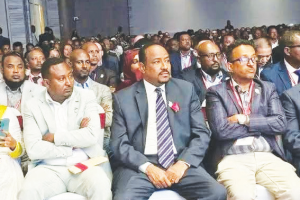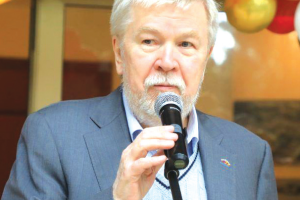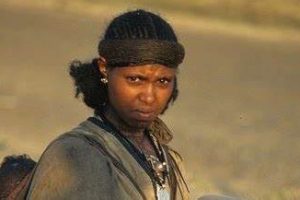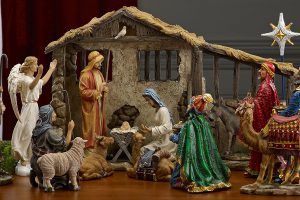
Different artistic styles come and go like fads. Some of them are easily forgotten. Others tend to remain longer than expected. Still others refuse to go away and become part of people’s identity, imagination or spirit. Ethiopian artist Lemmas Guya’s works tend to reflect unchanging times and merge into the psychological makeup of the people of Ethiopia. Lemma Guya lived and worked in a specific social milieu but his art reflects the natural beauty of an entire country.
Whether you go to Bishoftu or Bahir Dar or Hawassa or Adwa, art reflects not only the natural beauty of those areas but also the common destinies of the people who inhabit those places.
The tourist standing in front of the phallic-shaped stones on the tombs of ancient tribal dignitaries in Tiya is also seeing the human condition as it was then and contemplating the universal human condition, that of death, as portrayed by the symbolic stones.
My guess is that Lemma Guya simply painted nature or human life as he saw it in his native village or town. That is why Lemma Guya is portrayed as an Ethiopian naturalist painter who introduced innovation and a new dimension to the kind of naturalism other painters before him resort to.
I met artist Lemma Guya for the first time for an interview in the old editorial office of The Ethiopian Herald on the seventh floor of the building that sheltered the Berhanena Selam printing press.
My first impression of him was that of a very energetic person, with a well-built physique who might have come from a farming background. He had something of a man of the soil about him. His manners were not only pastoral. He was also well-versed with urban life and the realities of the African artistic world through his friendship with many African diplomats and renowned personalities.
The tall, fast speaking and buoyant Lemma Guya had a full head of hair that had started graying. His artistic
passion was just boiling over the surface and this was most visible in his dynamic expressions, self-assured manners and his piercing little eyes that darted left and right when he was speaking on the subject of art. It was later in our conversation that I learnt that the man who was speaking to me was an artist, a painter to be more exact, and that he was already one of the best known visual artists in the country.
My last encounter with Lemma Guya came at a time when he opened his African Art Centre in his native Bishoftu that has now become a must go place in the burgeoning town. This modern centre holds an impressive collection of Lemma Guya’s artistic productions he proudly displayed in the gallery he built with great efforts by overcoming many odds on the way.
I remember him telling me that he had difficulties acquiring the land on which he built the Centre. There were people who objected the location of the Center and suggested that it should be built in Addis Ababa. However, his patience and efforts paid back and the Center now stands as a milestone of Ethiopian art in the town whose natural beauty with its lakes, its hills, verdant landscape in general- is breathtaking. Lemma Guya brought to life his lovely Bishoftu and its people as the town nurtured, inspired and promoted his artistic talent.
Lemma Guya did not wait until I fired the first shots of questions. He was so open and frank about his life that it took him a few minutes to declare himself an officer in the old Air Force who abandoned the army because of his passion for art. He spent almost all his life in the air force base town of Debre Zeit or Bishoftu and that his paintings mostly depicted the lives of ordinary farmers in the area engaged in daily activities: shepherds looking after cattle, beautiful Oromo girls fetching water from clear rivers and lakes. His colors are vivid, blue and green most prominent featuring in most of his painting that capture the beauty, dynamism and hope of life in the rural backyards.
Lemma Guya’s artistic themes almost always rotate around rural lives, sunsets, sunrises, green fields, golden-red dawns, rivers, mountains, and farmers working in the fields. He is rather a born naturalist. Later on he introduced and of course the new material that has become another medium of expression for many decades now. He started to work with animal skins that became his own discovery and his sole specialty. He is not a modern painter in the sense Eskender Bogossian or Gebre Kristos Desta were. He is a traditional painter dealing with traditional themes and working with materials such as animal skin. There is no trace of cubism, expressionism, or abstraction.
He is rather a realistic painter in the tradition of old church painters who did portraits of saints and angels on church walls. The difference is that Lemma Guya deals with secular themes of everyday life while church painters claimed divine callings or expressed their faith in paintings.
There is no philosophy behind Lemma’s paintings. Life itself is his philosophy. His paintings are simple, plain and clear to every layman. Their beauty emanates exactly from their accessibility and understanding to the layman. You don’t need art connoisseurs to decipher Lemma’s works. They speak for themselves and speak the language of realism or naturalism.
Although that was the time when the art world was dominated by the likes of the late Maitre Artist Afewerk Tekle and the handful of artistic heavy weights, Lemma Guya had also cut his own corner in the domestic art world. He continued to develop his own style, themes and colors. Lemma Guya chose to differ without being intimidated by new styles of painting, mainly reflecting foreign and predominantly Western artistic influences.
Artist Lemma Guya stuck to his roots and continued to work in the tradition of his own form of naturalism and realism. His new portraits of African personalities on animal skins gained him greater recognition not only as a genuinely Ethiopian painter but as an African artist who uses African themes and express them with African materials. His portrait of Nelson Mandela and other prominent African leaders are masterpieces of portrait painting. Unlike many African artists, Lemma Guya does not seem to be attracted by the trademark African art of making masks with different materials.
African masks are at the centre of artistic creation or expression in many African countries such as Nigeria where gods, goddesses and spirits are represented in masks made of wood, steel or any other materials. The great Spanish-French cubist painter Pablo Picasso has been inspired by African masks and has produced his “cubists” masks as part of his masterpieces.
Not so with Lemma Guya whose preference is animal skin on which he continues to produce amazing works of realistic art with vivid colors and traditional themes of Ethiopia rural life.
What is also interesting about Artist Lemma Guya is that his children were more or less involved in artistic vocations. His daughter is a painter in her own right and lives in the US. One of his sons specializes in photography and runs a studio in Bishoftu which is also an art form. So, art seems to run in his family.
This is a rare phenomenon because artistic calling rarely runs in families. Politicians often beget politician children or traders produce their inheritors but so do rarely artists who do not often see their children falling in love with art. This may be because art has nothing to do with power or money but expresses the deepest aspirations of the soul. Lemma Guya should feel lucky for sharing his artistic soul with his children while he is still alive. `
Artist Lemma Guya has made a significant contribution to popularizing Ethiopian art by showing Ethiopian natural landscapes and its people to the outside world. His works are popular both within Africa and outside it. His artistic energy, which impressed me almost three decades ago, seems still intact although time has inevitably left its mark on his face.
No description of Ethiopian art would be comprehensive without putting Lemma Guya somewhere among the ranks of the greats of Ethiopian painting. His persistence, lifelong commitment and 65 years of arduous labor make him one of the living icons of Ethiopian traditional art at its best as reworked in his magic hands and is handed over to posterity.
The Ethiopian Herald Sunday Edition 15 September 2019
BY MULUGETA GUDETA





